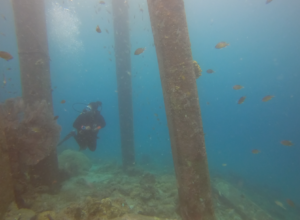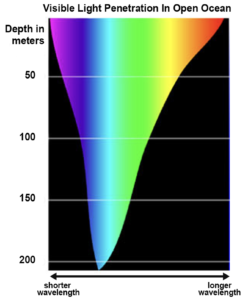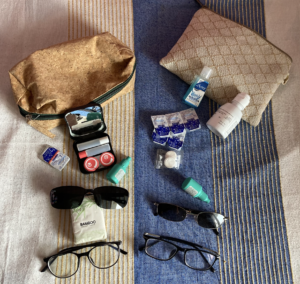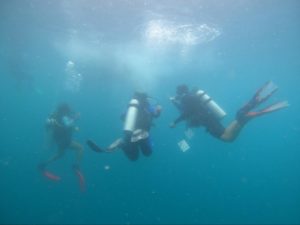
I was diagnosed with keratoconus at a time in my life when I was enthusiastic about changing the world. What I ended up changing, however, were seven prescriptions and five doctors over the course of two years, before a specialist finally diagnosed my condition.
These were not the only changes I was dealing with — I also had to adapt my lifestyle to accommodate for the considerable vision loss, which came with its own set of challenges. Driving at night became traumatizing, as the lights of the vehicles coming from the opposite direction were excruciatingly painful to my eyes. Reading was difficult, so I had to limit my reading time. I could no longer read whenever I felt like it. Watching TV, I could no longer make out subtitles on movies, TV shows, and videos, so I could only watch content in languages that I can understand.
Worst of all, I worried that because of my keratoconus, I would have to give up on my dream of underwater exploration – something that I had been wanting to do since I was five years old. Being diagnosed with keratoconus at the age of 19, the possibility of being able to dive was uncertain, just like my vision. I wore glasses constantly and there was no way I could dive with those, and even with a prescription, my vision was still not very clear. But, I didn’t give up hope and I learned that there is always a light at the end of the tunnel (or in my case – under the ocean!).
Finding a Way
At the time, I mustered the courage to get over my fear and insecurity of not being able to see perfectly. I booked a dive vacation to the most beautiful place — the Andaman and Nicobar Islands in India. While I was booking the vacation, I casually mentioned to the dive shop manager that I had poor vision and wore lenses. She confidently said, “Don’t worry about it, we’ll adapt your experience accordingly.”
At first, I thought I would just dive for the experience of it, but then I grew tempted to get my dive license so I could explore the vast ocean at my own pace. I worried about how my keratoconus might limit me, but I went ahead and registered for the course, with the ultimate goal of becoming a certified diver! With these dreams and a determination not to let my condition hold me back, I packed my bags and headed to Andaman.
Prior to embarking on my dive vacation, I had lots of questions about diving with eye conditions, such as how to see better underwater, understanding water visibility, and what to pack. Chances are if you are someone who is living with keratoconus and are considering taking a dive vacation, some of these questions may be on your mind as well. Below, I’m sharing the answers to all of my questions.
How To See Clearly Underwater
Divers wear a specialized mask that facilitates breathing underwater, but the equipment doesn’t support wearing glasses. Most dive schools and shops do have some masks with prescription power, but they are limited in number and usually only carry masks with “average” to low correction. Since most people with keratoconus usually have stronger prescriptions, diving while wearing contact lenses can be another option.
I have tried multiple lenses over the past 12 years, including hard lenses, specialty lenses, and scleral lenses, but I found custom-designed soft lenses to be the most comfortable option for me. If you’re planning to go diving or swimming, talk to your doctor about the best solution for you.
Having the Best Visibility Underwater
Diving has a learning curve, and poor vision only adds to the complexity. However, there are a few advantages for us — yes, that’s right, advantages! Objects in water are already magnified, so in that sense, it’s easier to spot the extravagant flora and fauna. That being said, there are multiple external factors that impact visibility underwater, including sediments, storminess, cloudy days, the depth of the dive, etc. For beginners and anyone living with keratoconus, I highly recommend diving only during diving season, so that you are able to make the most of your time underwater.

Once, while I was diving and exploring, there was a storm with dense, dark clouds blocking any possible sunlight from penetrating the ocean. I was barely able to see anything, even in water as shallow as eight meters (approximately 26 feet). I had to stick close to my dive buddy and depended on them to guide us both to safety. This was a bit challenging, but the experience was immensely memorable nonetheless!
Medium and depth also impact the brightness of colors underwater. There are certain shades that you will be able to see and others that may seem dim. It is not keratoconus that causes this, but the combination of the depth and being underwater that may impact your ability to see colors brightly. I have spotted some amazing flora and fauna that looked rather flushed-out at the time, but I learned that the reason they looked that way was because of how colors change underwater! I was fascinated and felt grateful that it was not my condition acting up. Check out this video to learn more about this phenomenon.
Packing for a Dive Trip
Packing for a dive trip takes some planning and preparation. For those who like to be more prepared, I’m sharing my list of things to pack for your dive vacation below.
- Lenses and Solution – I wear soft lenses which can tear without warning so I usually carry spare lenses and solution in my bag, no matter where I am. I also used to carry a spare set when I wore hard lenses, since they would fall off my eye sometimes. In general, I think it’s a good practice to carry spare lenses all the time! When diving, if water gets into your mask, simply remove your mask completely and put it back on. This is something I was petrified about since I wore contacts, but my instructor eased me into the process of it and helped me overcome my fear. It’s scary not being able to see, but work with yourself, be patient, and it will all fall into place!
- Glasses – You’ll definitely need glasses for your trip for when it’s time to take off your contacts. I typically pack one spare pair, since I like to be prepared for anything.

- Sunglasses – If your destination is tropical, then chances are you already have sunglasses in your bag. That being said, I often pack two pairs, just in case.
- Eye drops – Don’t forget to pack your eye drops, if you need them! If you are a person who is living with keratoconus, the odds that you have dry eyes are pretty high. While these are often available over the counter across the world, finding a convenient medical store near your dive location could sometimes be challenging, so it’s best to have these handy. If you use prescription eye drops, pack those too!
- Mirror – Don’t make the same mistake as me – pack a small mirror! One time, I unfortunately took my lens case that does not have a mirror. On the stormy day of the dive, the wind was strong enough to dislodge my lens from its place. I had to rely on my instructor to look into my eye and help me find it. It’s best to carry the entire lens case box that comes with a small convenient mirror and not just the lens case.
As you can see, I carry a lot of spares! I pack all of my daily-use items in an easy to carry pouch and ask my instructor to carry the pouch in their dry bag every time we go into the ocean. I have never had to use anything from the pouch, but it is a great source of comfort knowing that in case my eyes need any attention, I just have to resurface and I’ll find it all in that one pouch.
Time to Get Underwater!
I know all of this may feel overwhelming at first, but once you actually take the plunge and decide to explore the ocean, the preparation is all worth it! Trust me – I am less inhibited now, even with my keratoconus. To anyone considering diving, I would highly recommend it – especially for those living with keratoconus. Give yourself a break and the ocean a chance!
For any questions about diving, Shradha recommends getting in touch with her dive masters, Hayat Sadri and Rohin Unvalla. Both are SSI and PADI coaches with years of diving experience. To follow Shradha’s travels, click here!

